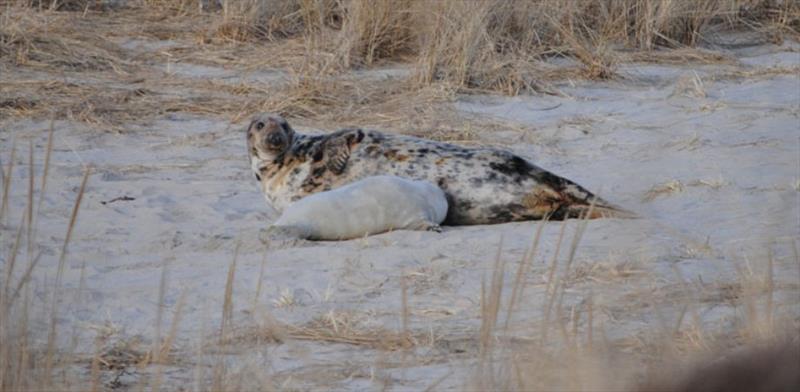
Reminder: Seals need space
by NOAA Fisheries 2 Feb 2019 14:56 UTC

Gray seal and pup © NOAA Fisheries
With daily reports of seals and seal pups coming into our hotline, this is a good time to remind everyone of seal watching guidelines and information.
Gray seals pup this time of year in New England, with pupping season extending through March. Then, in May, harbor seal pupping season begins.
Seal pups are adorable, but the best thing you can do for them is to keep your distance! Stay at least 150 feet (about four school bus lengths) away from seals, and keep pets away, too.
Despite good intentions, some beach goers take actions that put themselves and the seals at risk of injury. More often than not, interactions with seals leave the seals and their pups in dangerous situations--pups can be abandoned by their mothers, forced into the water when they aren't old enough, or fed foods that make them ill. (Even if it were legal to feed seals, which it is not, they don't eat peanut butter and jelly, just FYI.) The people approaching are also at risk of being bitten by a terrified seal that just wants to be left alone.
If you see a seal that you think might be in trouble, please call the Greater Atlantic Region Marine Animal Hotline at 866-755-6622, so trained responders can assist.
No selfies with seals please!
The popularity of selfies and capturing any moment through photographs or video is posing a new threat to wildlife and humans, including seals. Getting too close to seals can scare the animals and change their behaviors. Quietly watching from a distance can be even more rewarding than getting the perfect shot. Use your zoom or a telephoto lens instead of a selfie stick, or put your camera down and take a moment to really appreciate how cool sharing the shore with seals can be.
Mother Knows Best
Pups don't swim very well-- which is the reason they are hanging back on the beach while mom hunts. It is normal for a mother seal to leave her young pup alone on the beach for up to 24 hours while she feeds. You may not see the mother, but if she sees you near her pup, she may not think it's safe to come back. It might only take a few seconds for you to snap the photo, but the mother may abandon her pup if she feels threatened. For the seal pup, the consequences can be devastating. Also, attempting to put or chase a seal pup into the water can cost the pup it's life.
Even if the mother is present, if a curious seal pup approaches on its own, the right move is to back away so the mother doesn't perceive your interaction as a threat and abandon the area, leaving her pup behind.
Are you too close?
Is the seal waving its flippers? Does it look sleepy and is repeatedly yawning? Do you hear it barking or making any other noises? If so, then, YES, you are too close! Despite their appearance, these aren't friendly behaviors. They are the seal's way of telling you to back off because it is uncomfortable and getting nervous. Is the seal moving away from you? Another sure sign that you are encroaching on its personal space.
More Info
Print out our handy Seal Viewing Guidelines cards, and find out more about how you can Share the Shore with seals.
Also, please keep in mind that there is currently a phocine distemper outbreak in the northeast, and we are monitoring the seal population as part of an ongoing Unusual Mortality Event investigation. Please be sure to keep pets away from seals for everyone's safety.